Vintage_Mania
Bachelor Dog
- Joined
- Apr 11, 2012
- Messages
- 11,314
- Reaction score
- 3,218
- Location
- Eersterivier
- Bike
- Triumph 900 Scrambler
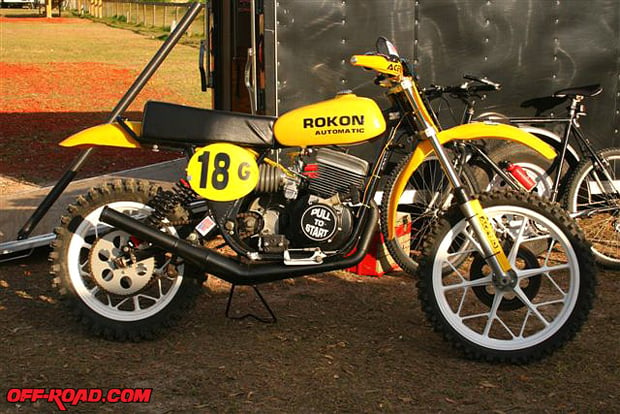
It seems, with only a few exceptions, that not much is new to the dirt bike world. Bold new graphics, sure. Fuel injection is “sort of” new but dirt bikes have been developing that since the early ‘90s and airplanes had fuel injection before WW2. But 1970 was different. The dirt bike market – and subsequently, technology – was expanding at an unprecedented rate. You name it, they’ve tried it. Perhaps the most radical of all the early ‘70s designs came from a little company in New Hampshire more famous for building unstoppable two-wheel drive ATVs.
Rokon’s weird two-wheel drive Rokon Trailbreakers were one thing, but when Rokon decided to cash in on the expanding dirt bike market things got really strange! The radical machine they came up was a clean-sheet dirt bike design. Remember, this was an era of pipey, piston-port two-strokes with hand-grenade reliability. Motocross riders had to be clutch artists, constantly tap-dancing the shifter just to keep the engines in their narrow powerband. Hop off a modern bike and onto a vintage motocross bike and you’ll instantly develop respect for pro riders of that era!
Instead of fighting that battle Rokon used a simple, reliable 340cc Sachs snowmobile engine. Transmission? What could be easier to use than a snowmobile-style Salsbury clutch? Twist and go. With an infinitely variable transmission Rokon engineers didn’t have to worry about a peaky powerband and could instead tune the engine for maximum power and simply adjust the clutch to keep the engine revving at the power peak all the time. A great idea, in theory at least, but would it work on a dirt bike?
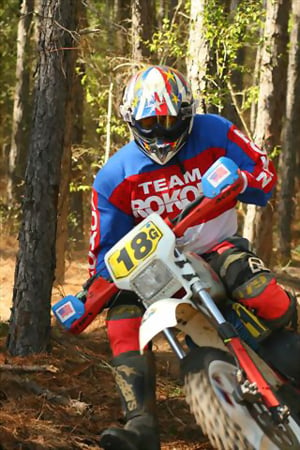
A big problem with CVTs is the lack of engine braking. Rokon needed more than the crummy mechanical drums so common on vintage bikes and was forced to use hydraulic discs. As if an automatic transmission dirt bike with disc brakes wasn’t different enough, Rokon went a step further by developing lightweight cast magnesium wheels. The end result of all this weird science was a fat (by early ‘70s motocross standards at least) but effective line of motocross, enduro and dual-sport bikes that won a whole bunch of ISDT medals, industry accolades for outstanding engineering and even earned AMA national motocross success.
In the early ‘70s I was a little kid wandering around at gas stops at Enduros in Ontario and Western New York. Ever curious, I was drawn to the strange bikes with their pull starters and weird looking wheels. Watching Rokon riders pull-start their bikes was a constant source of amusement for me at five years old!
By ’77 Rokon’s ride was over. The final Rokon prototypes, named RX500s, were a technological tour de force. The CVT remained, with a Maico 501 jug mated to the Sachs bottom end. The rear disc brake was mounted on the drive sprocket, which in turn was inline with the swingarm pivot. In many ways they were a cross between an ATK of the early ‘90s and a current BMW or Husky 450F.
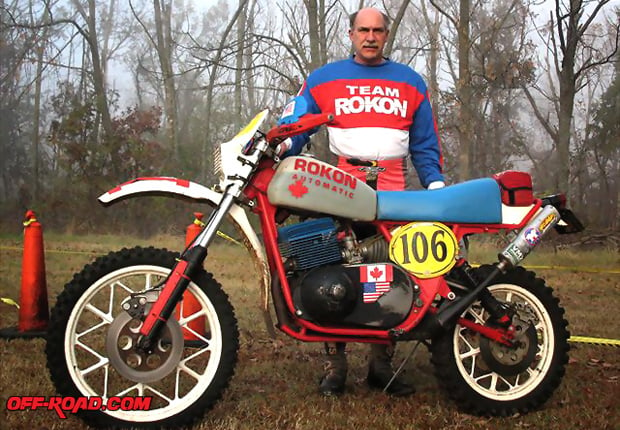
Also, like the cutting-edge Beemer and Husky, the RX500 prototype’s fuel tank was under the seat and the airbox was under the fake gas tank. If the first Rokons had fresh ideas then the RX500 prototype was a full-blown attack on conventional motocross design! The thing is the Japanese were selling boatloads of quick, reliable and most importantly “normal” dirt bikes. New clean-air regulations were effectively killing off Rokon’s line of two-stroke dual-sport bikes. Rokon was going broke. Re-inventing the dirt bike had financially ruined the company and Rokon was forced to cease production.
Rokon eventually recovered, and to this day continues producing 2WD Trailbreakers, but actual Rokon dirt bikes were history. Good ideas are good ideas, and through vintage racing they are reborn. Rokons, once considered somewhat crude in the execution of their radical ideas, have become among the most collectible vintage dirt bikes for good reason. They are rare, they are cool to look at and they inspire endless bouts of ‘what if?’ bench racing in the pits. For all their faults the one thing Rokons always were was fast, and thanks to that awesome CVT tranny a Rokon rider is practically guaranteed a holeshot in vintage motocross!
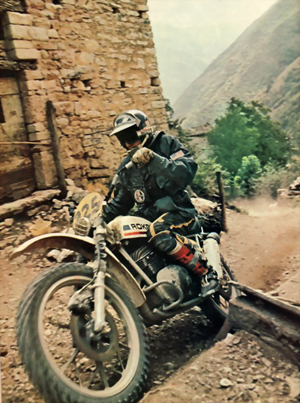
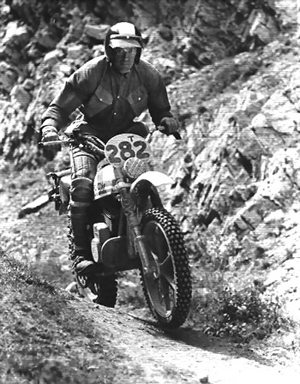
nspired to learn more about these innovative machines we tracked down Rokon ISDT star Jim Hollander (who later went on to start the Hot Grips heated grip company) and Rokon development rider ‘Rokon’ Mike Murphy, who now runs a small business called Rokon Renew that specializes in building and selling vintage Rokon race bikes.
“I happened to live just within 100 miles of the Rokon factory in NH,” explains Hollander. “I was asked by the President of Rokon to try out the bike when I was at the ISDT in Dalton, MA. I fell in love with the simplicity and ease of riding it.”

Murphy’s introduction to Rokon was at the R&D level. “A local Rokon dealer needed help, through the factory, on ideas to improve the new long-travel RT-2 model,” he says. “They just cut me loose on it to do whatever I wanted, and then would fix whatever I broke. I remember on the drive home from the shop my dad asked me, ‘Are you sure you want to ride, race & test a 250 lb dirt bike with a pull start snowmobile engine?’ After riding the Rokon I knew this machine was the missing link I’d been looking for! I was hooked from that day on.”
Rokon had proven themselves in 1973 with four finishers at the ISDT, but that publicity didn’t end the constant barrage of questions in the pits. “I noticed younger riders like myself, around 22 at the time, made a lot of jokes about it,” laughs Murphy. “They even called me ‘The lawnmower man!’”

If you’ve ridden a snowmobile you know the biggest advantage of a CVT transmission is incredible traction, which Rokon capitalized on. Hollander describes its operation. “Rokon's transmission is a torque converter set up like on a snowmobile, with a front drive sliding double cone arrangement off the engine crankshaft and then a rear driven torque converter, which was connected to a gear reduction box before output to the countershaft sprocket. It is torque sensing in that as the rear wheel slips the pulleys tend to up-shift into a higher ratio. There was a learning curve of a few weekends at local enduros in New England, but then it was much easier to ride than a shifter bike.”
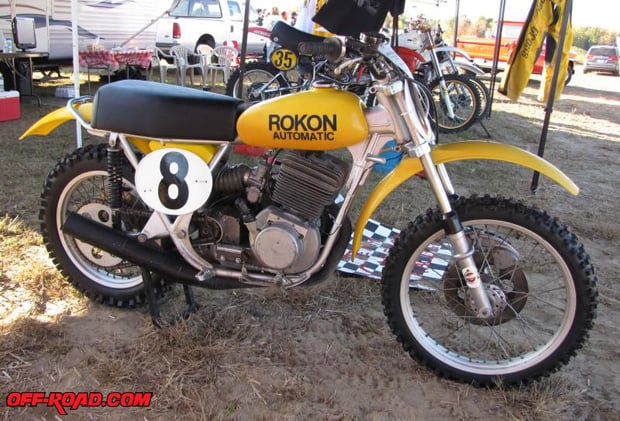
There were a few tricks to riding a Rokon effectively – things most magazine testers or weekend warriors never took the time to learn. “The hardest thing for me about learning to ride the bike was the disc brakes!” Murphy told us. “At that time we all had drum brakes that basically didn't work very well. The Rokon disc brakes did overheat but worked well at enduro speeds.”
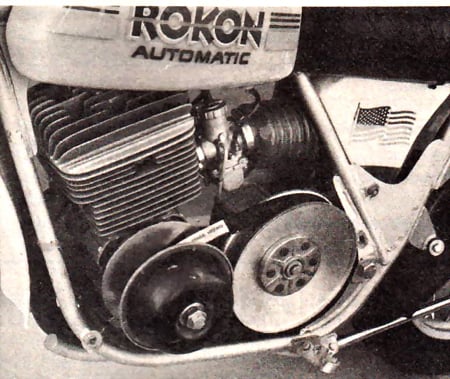
Taking full advantage of the CVT required a few tricks as well. “I developed a technique of riding the throttle against the rear brake, a bit like the rally drivers did with rally cars, and it made the bike super fast!” Hollander says.
If you took the time to adapt your riding style to the Rokon they were effective race bikes. David Mungenast holds an honoored place in the AMA Hall of Fame. Among his many accomplishments is a bronze medal earned at the Italian ISDT in 1974 while riding a Rokon for the Canadian team. In 1976 Hollander won the overall at an US ISDT Qualifier overall in Cass City, Michigan over Dick Burleson and the Penton brothers. In Austria at the ISDT, Hollander was the top scoring American trophy team rider and sixth American overall. Murphy used the same Rokon for motocross and hare scrambles and modestly says, “I seemed to always stay up front with most of the fast guys.” Florida motocrosser ‘Rokon Don’ Kudalski became famous for his speed in the sand about his auto-crosser.
Finding traction in sand and mud are one thing, but water could prove to be the CVTs undoing. “Rokon advantages?” Murphy says. “They always find traction and the disc brakes are great! Disadvantages? No engine braking and that rubber drive belt needs to say dry!” Hollander continues, “In deep water there was some slipping on the torque converter drive belt, but we finally got past that by slotting the belt edges on a table saw so they worked like a rain tire.”
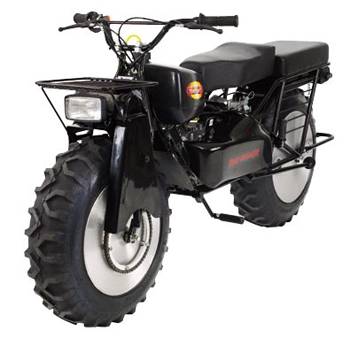
Motocross and off-road racing were a lot different 35 years ago than today. We wondered if a CVT would have adapted as well to 'new school' enduro with all the extreme and motocross-type elements? Is it even necessary now that EFI four-strokes have such wide, smooth powerbands? “I would be curious to ride a Rokon with modern suspension,” says Hollander, adding, “I am also very curious about the Christini two-wheel drive system and wonder how the combination would be of an automatic with 2WD! A modern automatic transmission would benefit a modern race bike, but there seems to be a lot of resistance to automatics even after Husqvarna won the National Enduro Championship on their automatic in the ‘80s.”
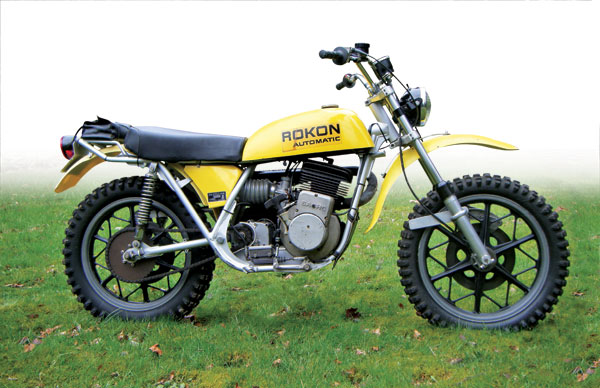
Hollander and Murphy remain proud of the Rokon and all the fresh ideas that went into building them. “Even though I never competed in the ISDT,” Murphy says, “I always have a good feeling about the accomplishments of the Rokon team when I see a picture or read an article about them. I only hope that the improvements we made to the Rokons worked their way up to the team riders. I was never able to meet any factory team members but one, Dave Mungenast. Dave and I became friends and even rode the Colorado 500 together back in 1995. I still have two black and white photos hanging in my shed, one of Dave in Italy and the other of Jim Hollander when he cleaned up and won the overall in Michigan!”




